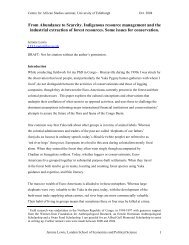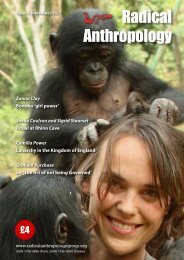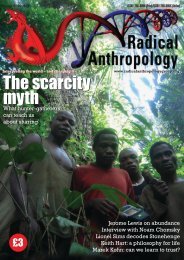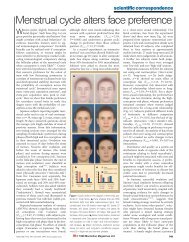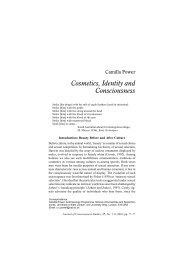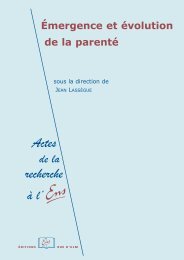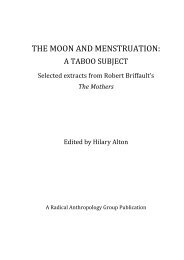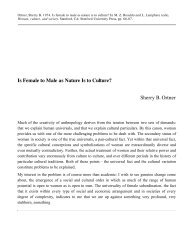Language and life history: A new perspective on the development ...
Language and life history: A new perspective on the development ...
Language and life history: A new perspective on the development ...
- No tags were found...
You also want an ePaper? Increase the reach of your titles
YUMPU automatically turns print PDFs into web optimized ePapers that Google loves.
Locke & Bogin: <str<strong>on</strong>g>Language</str<strong>on</strong>g> <str<strong>on</strong>g>and</str<strong>on</strong>g> <str<strong>on</strong>g>life</str<strong>on</strong>g> <str<strong>on</strong>g>history</str<strong>on</strong>g>rarely invoked in <strong>the</strong>ories of evoluti<strong>on</strong>) may assume botha direct <str<strong>on</strong>g>and</str<strong>on</strong>g> an indirect form. In <strong>the</strong> direct case, behaviorsof <strong>the</strong> young (e.g., infants’ strategic use of creative <str<strong>on</strong>g>and</str<strong>on</strong>g>complex vocalizati<strong>on</strong>s) forestall withdrawal of care,increasing <strong>the</strong> probability of survival to reproductive age.In <strong>the</strong> indirect form, it is <strong>the</strong> behavior of sexually matureindividuals that is selected, typically in <strong>the</strong> quest forstatus <str<strong>on</strong>g>and</str<strong>on</strong>g> mating opportunities, but that behavior is <strong>on</strong>lyavailable to be selected because it, or a precursive form,has a prior <strong>development</strong>al <str<strong>on</strong>g>history</str<strong>on</strong>g>. These cases of selecti<strong>on</strong>in adolescence or early adulthood automatically reinforce<strong>the</strong> earlier, enabling behaviors.In o<strong>the</strong>r primates, it has been proposed that <strong>the</strong> juvenileperiod is beneficial because it permits developing animalsto prepare for <strong>the</strong> complexities of adult behavior. Similarly,we reas<strong>on</strong>ed that human juvenility may have provideda period in which capabilities emerging inprevious stages could be “practiced,” <str<strong>on</strong>g>and</str<strong>on</strong>g> <strong>the</strong>n, in adolescence,more fully exercised for social <str<strong>on</strong>g>and</str<strong>on</strong>g> sexual purposes.Although we suggested that selecti<strong>on</strong> operated throughout<strong>on</strong>togeny, we also speculated that in adolescence, performativebehaviors (including socially attractive aspects ofarticulate vocalizati<strong>on</strong>) increased fitness, established apreferred mode of expressi<strong>on</strong>, <str<strong>on</strong>g>and</str<strong>on</strong>g> laid <strong>the</strong> groundworkfor speech as <strong>the</strong> universal modality of language.We based our speculati<strong>on</strong>, in part, <strong>on</strong> anthropologicalreports indicating that in oral societies – which lack <strong>the</strong>written language bias of modern cultures <str<strong>on</strong>g>and</str<strong>on</strong>g> modernLinguistics – fluent, rhythmic, <str<strong>on</strong>g>and</str<strong>on</strong>g> elegant speech attractsattenti<strong>on</strong> <str<strong>on</strong>g>and</str<strong>on</strong>g> facilitates <strong>the</strong> acquisiti<strong>on</strong> of status <str<strong>on</strong>g>and</str<strong>on</strong>g>power. This trend is most evident in <strong>the</strong> case of men, inc<strong>on</strong>trast with <strong>the</strong> “female advantage” that has beenreported in <strong>the</strong> psychometric literature, discouraging <strong>the</strong>oristsin search of a selecti<strong>on</strong>-based model in which malesdisplay, <str<strong>on</strong>g>and</str<strong>on</strong>g> are chosen for, <strong>the</strong>ir verbal talent. Witnessinga male bias for performative speech, we speculated thatselecti<strong>on</strong> produced sex differences that remain evident inverbal behavior today.If childhood entered <strong>the</strong> human genome first, <strong>the</strong>amount of vocal-motor c<strong>on</strong>trol available to our premodernancestors may have remained limited, even if enhanced injuvenility, until <strong>the</strong> evoluti<strong>on</strong> of adolescence. Then, <strong>the</strong>performative applicati<strong>on</strong>s of such behaviors, <str<strong>on</strong>g>and</str<strong>on</strong>g> <strong>the</strong> behaviors<strong>the</strong>mselves, would almost certainly have diversified.Hence, we think <strong>the</strong>re may have been a l<strong>on</strong>g period inevoluti<strong>on</strong>ary <str<strong>on</strong>g>history</str<strong>on</strong>g> in which vocal behaviors were displayedwithin a familial c<strong>on</strong>text, before adolescenceteased <strong>the</strong>m into <strong>the</strong> open in more elaborate form.We proposed that important aspects of language cannotdevelop until sexual maturity because functi<strong>on</strong>s thatemerge at that stage played, <str<strong>on</strong>g>and</str<strong>on</strong>g> still play, a key role inits c<strong>on</strong>structi<strong>on</strong>. When selecti<strong>on</strong> for vocal <str<strong>on</strong>g>and</str<strong>on</strong>g> verbalperformance in adolescence reinforced previous <strong>development</strong>s,it swept specializati<strong>on</strong>s associated with speech <str<strong>on</strong>g>and</str<strong>on</strong>g>voice, linguistic c<strong>on</strong>tent <str<strong>on</strong>g>and</str<strong>on</strong>g> structure, <str<strong>on</strong>g>and</str<strong>on</strong>g> rules of usageinto <strong>on</strong>e large specializati<strong>on</strong>. It is difficult to escape <strong>the</strong>c<strong>on</strong>clusi<strong>on</strong> that <strong>the</strong> faculty of language includes severaldisparate capabilities, <str<strong>on</strong>g>and</str<strong>on</strong>g> that <strong>the</strong>se capabilities werestitched toge<strong>the</strong>r in evoluti<strong>on</strong>, as <strong>the</strong>y are in moderntimes, by <strong>the</strong> whole of human <strong>on</strong>togeny.ACKNOWLEDGMENTSThe authors wish to acknowledge helpful discussi<strong>on</strong>s with, orcomments by, Tom Dickins, Tecumseh Fitch, Cathy Flanagan,Gilbert Gottlieb, Peter LaFreniere, Kim Oller, Ca<strong>the</strong>rineSnow, <str<strong>on</strong>g>and</str<strong>on</strong>g> especially, Michael Studdert-Kennedy.NOTES1. Arbib (2005a; 2005b) has suggested that at some point inevoluti<strong>on</strong>, hominins may have used manual gestures <str<strong>on</strong>g>and</str<strong>on</strong>g> vocalsounds to communicate; <strong>the</strong> gestures – in pantomime – carryingsemantic <str<strong>on</strong>g>and</str<strong>on</strong>g> possibly sequential informati<strong>on</strong> of <strong>the</strong> sort nowc<strong>on</strong>veyed by syntax (Goldstein et al., in press).2. In human ne<strong>on</strong>ates, body weight is nearly twice that ofchimpanzees, <strong>the</strong> difference being due, in large measure, to<strong>the</strong> abundance of fat. This extra fat provides a source of energyto support <strong>the</strong> large <str<strong>on</strong>g>and</str<strong>on</strong>g> still rapidly growing brain of <strong>the</strong>human infant (Bogin 1999b), which is three times larger than<strong>the</strong> chimpanzee brain at birth (Martin 1983). In fact, human<str<strong>on</strong>g>new</str<strong>on</strong>g>borns are neurologically more advanced than eight o<strong>the</strong>rmammalian species that have been studied; two m<strong>on</strong>thsbefore birth, <strong>the</strong> human brain is already more developed than<strong>the</strong> brain of <strong>the</strong> <str<strong>on</strong>g>new</str<strong>on</strong>g>born macaque (Clancy et al. 2001).Fur<strong>the</strong>r disparities develop at birth, when brain growth tapersoff in <strong>the</strong> o<strong>the</strong>r primates, whereas in humans it c<strong>on</strong>tinues for<strong>the</strong> next year in a rapid, fetal-like trajectory (Martin 1983).Because of <strong>the</strong>se differences, <strong>the</strong> brains of human ne<strong>on</strong>atesrequire more nutriti<strong>on</strong> than do <strong>the</strong> brains of o<strong>the</strong>r primate <str<strong>on</strong>g>new</str<strong>on</strong>g>borns(Le<strong>on</strong>ard & Roberts<strong>on</strong> 1992; see below); <str<strong>on</strong>g>and</str<strong>on</strong>g>, althoughcomparative data are not readily available, it is clear that socialstimulati<strong>on</strong> also plays a significant role in human neurological<strong>development</strong> (e.g., Rutter & O’C<strong>on</strong>nor 2004).3. The “gr<str<strong>on</strong>g>and</str<strong>on</strong>g>mo<strong>the</strong>r hypo<strong>the</strong>sis” is indirectly relevant to ourdiscussi<strong>on</strong>. Human beings are <strong>the</strong> <strong>on</strong>ly primate species, <str<strong>on</strong>g>and</str<strong>on</strong>g> <strong>on</strong>eof <strong>on</strong>ly a few mammalian species, in which adult females have amenopause <str<strong>on</strong>g>and</str<strong>on</strong>g> a cessati<strong>on</strong> of ovulati<strong>on</strong> l<strong>on</strong>g before death.Women are usually infertile by <strong>the</strong> age of 50, but may have twodecades of post-reproductive <str<strong>on</strong>g>life</str<strong>on</strong>g> in traditi<strong>on</strong>al societies(Pavelka & Fedigan 1991). The “gr<str<strong>on</strong>g>and</str<strong>on</strong>g>mo<strong>the</strong>r hypo<strong>the</strong>sis”posits that this post-reproductive stage of <str<strong>on</strong>g>life</str<strong>on</strong>g> evolved becauseolder women st<str<strong>on</strong>g>and</str<strong>on</strong>g> to gain more reproductive advantage byhelping <strong>the</strong>ir daughters <str<strong>on</strong>g>and</str<strong>on</strong>g> gr<str<strong>on</strong>g>and</str<strong>on</strong>g>children than by investing inmore children of <strong>the</strong>ir own (Bogin & Smith 1996; Hamilt<strong>on</strong>1966). Hill <str<strong>on</strong>g>and</str<strong>on</strong>g> Hurtado (1991) tested this predicti<strong>on</strong> againstobjective ethnographic data derived from <strong>the</strong>ir work with <strong>the</strong>Ache hunter-ga<strong>the</strong>rers of South America. The Ache data showthat offspring with gr<str<strong>on</strong>g>and</str<strong>on</strong>g>mo<strong>the</strong>rs survive at somewhat higherrates than those without gr<str<strong>on</strong>g>and</str<strong>on</strong>g>mo<strong>the</strong>rs, but <strong>the</strong> effect is notnearly enough to account for menopause. In a review of <strong>the</strong>Ache data <str<strong>on</strong>g>and</str<strong>on</strong>g> o<strong>the</strong>r cases derived from hunting-ga<strong>the</strong>ring <str<strong>on</strong>g>and</str<strong>on</strong>g>agricultural societies, Austad (1994) found no evidence “thathumans can assist <strong>the</strong>ir descendants sufficiently to offset <strong>the</strong> evoluti<strong>on</strong>arycost of ceasing reproducti<strong>on</strong>” (p. 255). Still, interest in<strong>the</strong> “gr<str<strong>on</strong>g>and</str<strong>on</strong>g>mo<strong>the</strong>r hypo<strong>the</strong>sis” c<strong>on</strong>tinues; Hawkes et al. (1998)used ma<strong>the</strong>matical modeling techniques to show ways thatmenopause could have evolved under Darwinian selecti<strong>on</strong>.4. When is <strong>the</strong> human capacity for language, or linguisticcommunicati<strong>on</strong>, fully instated in <strong>the</strong> young? When does itbecome fully operati<strong>on</strong>al? In <strong>the</strong> case of printed language, itwas <strong>on</strong>ce possible to specify <strong>the</strong> materials that <strong>on</strong>e needed toread, such as <strong>the</strong> Bible or <str<strong>on</strong>g>new</str<strong>on</strong>g>spaper, or to link competence tolarger individual or cultural <str<strong>on</strong>g>and</str<strong>on</strong>g> ec<strong>on</strong>omic goals. In <strong>the</strong> case ofspoken language, <strong>the</strong>re seem to be no clear-cut criteria formastery. Therefore, <strong>the</strong> st<str<strong>on</strong>g>and</str<strong>on</strong>g>ard that has developed in modernsocieties, perhaps by default, is linked most immediately tosocial reacti<strong>on</strong>s in childhood <str<strong>on</strong>g>and</str<strong>on</strong>g> to academic success, includingliteracy. At <strong>the</strong> age of six, more than 96% of MidwesternAmerican children pass normed tests that emphasize ph<strong>on</strong>ology,morphology, syntax, <str<strong>on</strong>g>and</str<strong>on</strong>g> vocabulary. These tests are sensitiveto language skills that are deemed necessary for success ineducati<strong>on</strong>al programs (Tomblin et al. 1996).5. Some of <strong>the</strong>se functi<strong>on</strong>s, including sarcasm, joking, <str<strong>on</strong>g>and</str<strong>on</strong>g>idiomatic interpretati<strong>on</strong>, are h<str<strong>on</strong>g>and</str<strong>on</strong>g>led primarily by <strong>the</strong> so-calledn<strong>on</strong>linguistic (right) cerebral hemisphere (cf. McD<strong>on</strong>ald 2000;278 BEHAVIORAL AND BRAIN SCIENCES (2006) 29:3



